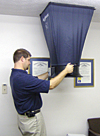
Measuring airflow from a supply register with a flow hood is David Richardson, owner of Richardson Heating and Air Conditioning, Frankfort, Ky.
Through diagnostic testing, Richardson said a contractor will find some very disheartening things going on with his/her own installations that need to be taken care of “before you go out and save the HVAC world from itself.”
“I know we did,” he said. “Take the time to learn from your mistakes and be honest with yourself. You won’t learn anything by ignoring the facts.”
Richardson could not say enough about pushing airflow diagnostics. “The airflow diagnostic is the biggest inquiry we have in the diagnostic processes we use,” he said. “This series of tests is the key to identifying key problems related to the HVAC system, such as hot/cold spots, dust issues, high utility bills, and frequent equipment breakdowns.
“I think it is a hit because we are focusing on trying to provide real solutions, instead of just trying to get our foot in the door to sell equipment or other band-aids that the customer really doesn’t need. They are looking for answers. It is our job to provide them.”
He added, “There are no smoke and mirrors and no gimmicks when it comes to the testing. It is nothing but the true operation of the system as is, when tested at that point in time. The test is very simple to understand and very simple to relay to the customer.”
While people seem to be fascinated with the flow hood and smoke puffer, the real fun is to see the expression on the customer’s face “when they make the discoveries about their HVAC system with you.”
KEEP THESE TIPS IN MIND, TOO
Among other diagnostic tools, Mike Graham incorporates flow hoods, magnehelic infrared thermometers, anemometers, blower doors, duct blasters, and infrared cameras. The owner of Mike Graham Heating and Air Conditioning, Burkburnett, Texas, noted that such equipment is not only used in finding solutions for problem homes or businesses, the tools are also used for verifying if work has been done properly.“Performing these tests is second nature to us and doing the job another way would not be fair to the customer,” said Graham. “We, as HVAC professionals, have an obligation to our customers and to our industry. We cannot install equipment and not measure the performance of that system. If we fail to do that, then we have not given the customer what he or she has paid for. And you, as an HVAC professional, have not done your job - period.”
Benjamin DiMarco, head of DiMarco & Associates, Cleveland, believes that any diagnostic process that identifies a problem or deficiency correctly is an effective tool.
“This can come from complex airflow diagnostics, coupled with infiltration testing, thermal imaging, pressure measurement, and controls diagnostics, to something as simple as smoke pencil testing for air movement,” offered DiMarco. “To do this economically, you need a solid understanding of buildings, how they are supposed to operate as a whole, and an understanding of lean processes.”
To head in the right direction, DiMarco suggested contractors learn more about total building commissioning, the Leadership in Energy and Environmental Design (LEED) Green Building rating system, and lean. (Lean manufacturing and production processes originated as the set of Toyota Production System tools that assist in the identification and steady elimination of waste, the improvement of quality, and production time and cost reduction.)
“Measurement devices for airflow, water flow, electrical measurement, pressure measurement, or any software program for measurement are only of value if used synergistically, when and where necessary,” he said.
“The diagnostic tools for the HVAC and building industry are out there. You just have to know what to use and when. Getting the results, such as improved comfort, reduced energy bills, better ‘measured’ IAQ, and lower maintenance costs are what’s important.”
Travis Klein, a comfort consultant for Mechanical Service Co., Virginia Beach, Va., offered another important tip.
“Ultimately, dealers need to realize that they cannot continue to try and do the most amount of work for the lowest possible price,” he said. “It is impossible to deliver what is asked for, stand behind it, train, grow, advance, buy new tools, and stay ahead of the curve if price continues to be their only concern.
“Because they do not use smart tools and perform diagnostics, they are left to compete with everyone else as the lowest common denominator. In the end, everyone loses because customers are left unhappy, employees don’t grow, companies aren’t profitable and cannot prosper. In the end, there is no one left to support that system installation.”
Publication date:10/08/2007

Report Abusive Comment